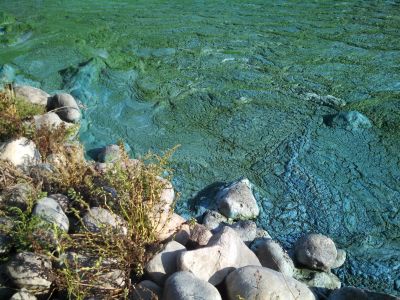Source: North Dakota State University | 6-24-19
Cyanobacteria, also known as blue-green algae, can produce toxins that are harmful to livestock, wildlife and people.
“The growth of this bacteria is facilitated by the high temperatures common in July and August,” says Miranda Meehan, North Dakota State University Extension livestock environmental stewardship specialist. “Blue-green algae often occurs in stagnant ponds or dugouts with elevated nutrient levels, forming large colonies that appear as scum on or just below the water surface. Live cyanobacterial blooms can be green, but also red or yellow, and often turn blue after the bloom dies and dries on the surface or shoreline.”

NDSU Extension is starting to receive reports of blue-green algae in stock ponds used for livestock water. In addition, several water samples submitted to the NDSU Veterinary Diagnostic Laboratory have tested positive for cyanobacteria.
“We expect to see the occurrence of blooms increase with temperatures during the next week,” Meehan says. “Areas of the state experiencing drought will have an increased risk.”
Some species of cyanobacteria can be toxic when livestock and wildlife ingest them. Toxicity is dependent on the species consuming the water, the concentration of the toxin or toxins and the amount of water ingested.
Cyanobacteria can produce neuro and liver toxins. Signs of neurotoxin poisoning can appear within five minutes to up to several hours after ingestion. In animals, symptoms include weakness, staggering, muscle tremors, difficulty breathing, convulsions and, ultimately, death.
Animals affected by liver toxins may exhibit weakness, pale-colored mucous membranes, mental derangement, bloody diarrhea and, ultimately, death.
Typically, livestock are found dead before producers observe symptoms. If cyanobacterial poisoning is suspected as the cause of death, producers should check the edges of ponds for dead wildlife.
When collecting a water sample, follow NDSU Extension’s “Livestock Water Testing Guidelines” (https://tinyurl.com/NDSU-LivestockWaterTesting).
“Be sure to wear gloves because cyanobacteria can be toxic to humans,” Meehan warns. “Collect a sample of the suspected cyanobacterial bloom from the surface of the water and deeper in the water. The sample should be kept cool but not frozen, and submit it to the NDSU Veterinary Diagnostic Laboratory or a commercial laboratory.
“The sample can be evaluated microscopically for algae, or the water can be analyzed for several of the toxins at commercial labs at a higher cost,” she adds.
For more information on sample collection and submission, contact your NDSU Extension agent.
Here are some ways producers can prevent cyanobacterial poisoning of livestock:
- Reduce nutrient levels entering the water source by implementing a nutrient management plan or establishing buffer strips with perennial plant species.
- Create a designated drinking area where the risk of cyanobacteria is minimal.
- Fence off the pond and pump water from the pond to the water tank.
- Use water from other sources following periods of hot, dry weather.
- Add copper sulfate to the water if the water has a history of algae blooms. Apply 2 pounds of copper sulfate per acre-foot of water, which is equal to a rate of 8 pounds per 1 million gallons. Livestock must be fenced out of treated water sources for at least 10 days.
For more information, check out NDSU Extension’s “Cyanobacteria (Blue-green Algae) Poisoning” publication at http://tinyurl.com/NDSU-blue-green-algae for more information.
